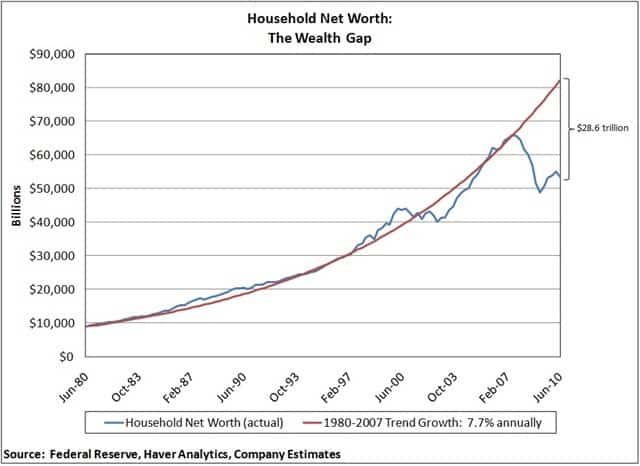The Wealth Gap
One of the goals of QE is to raise asset prices, as we have been told by Chairman Bernanke and Brian Sack among others, which should stimulate wealth-effect consumption. Leaving aside all of the obvious hazards of this strategy (moral and otherwise), this may be a less effective plan than expected for another reason entirely.
Household net worth has rebounded recently but is still at 2005 levels and, more importantly, is significantly lower than the household would have expected it to be at this point. From 1980 to 2007, net worth grew at 7.7% annually, which became somewhat ingrained in the psyche of the household. Households were able to spend more of their disposable income and “save” through gains in their portfolios and homes. However, since 2000 net worth has grown at only 2% annually, weathering the bursting of dual bubbles in equities and home prices.
Bernanke talked about a concept called a “price level gap” in his Japan speeches. The price level gap is the difference between the current price level and where the price level would have been had disinflation/deflation not taken hold. A lower than expected price level hurts a leveraged economy because the expected appreciation of prices (and devaluation of the currency) didn’t occur, leaving the borrower underwater and with a heavy debt burden to be repaid in a more valuable currency. This was the basis for Bernanke’s price level target prescription for Japan’s deflation.
Borrowing from that framework, if it is true that households came to expect a certain rate of net worth appreciation, after a decade of below expected growth there must now exist a sizeable gap between their expected level of net worth and their current net worth. This “wealth gap” is estimated in the chart below, and currently stands at $28.6 trillion.
We would expect that any wealth effect-driven consumption to be muted until this gap is significantly closed. The gap can also be closed by an increased household savings rate, and a deleveraging of the household balance sheet, two trends that seem to be already in place.
Keep in mind that the growth rate of net worth in the chart above is nominal, not inflation-adjusted. It would be easy to assume that the 7.7% rate of net worth appreciation between 1980 and 2007 isn’t compatible with the rest of history, but it is actually pretty close. Since the early 1950s, over long periods of time the nominal growth rate of net worth has fluctuated but has generally stayed over 7%. That suggests that this kind of “wealth gap” framework is robust to other time periods, and not related only to the Boomers, the Great Moderation bull market, and our current malaise. However, the existence of a much larger group of potential retirees now probably makes the negative spending effects of a big wealth gap worse than in previous periods.

This is bad news for the theory that QE can spur consumption due to some muted wealth effect. Households still feel relatively poor given the loss in housing and equities over the past few years. Especially for boomers, any wealth effects are likely to be muted.